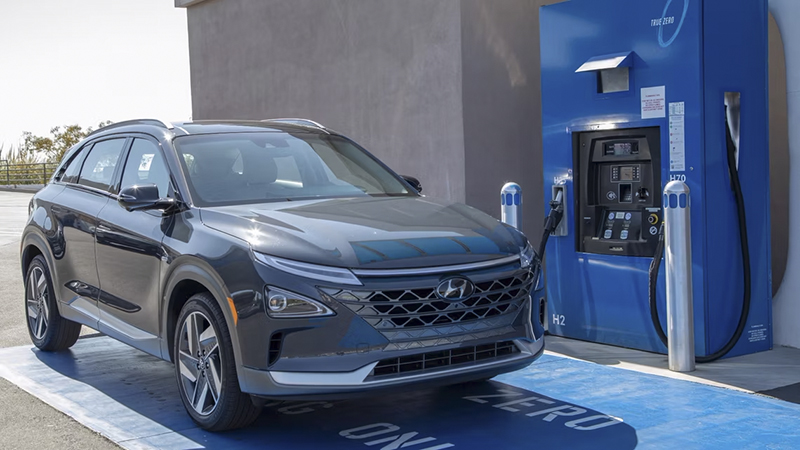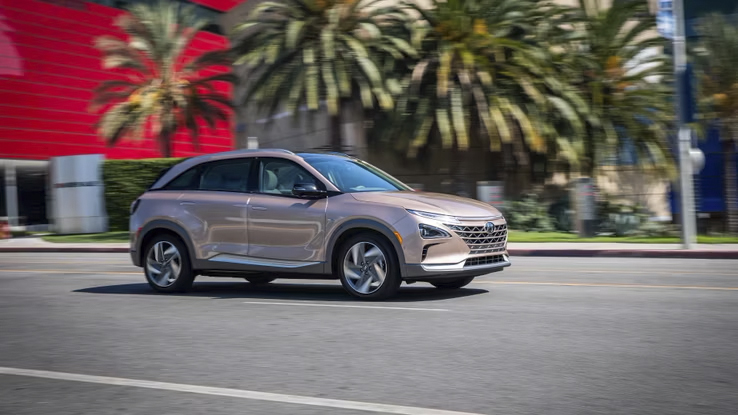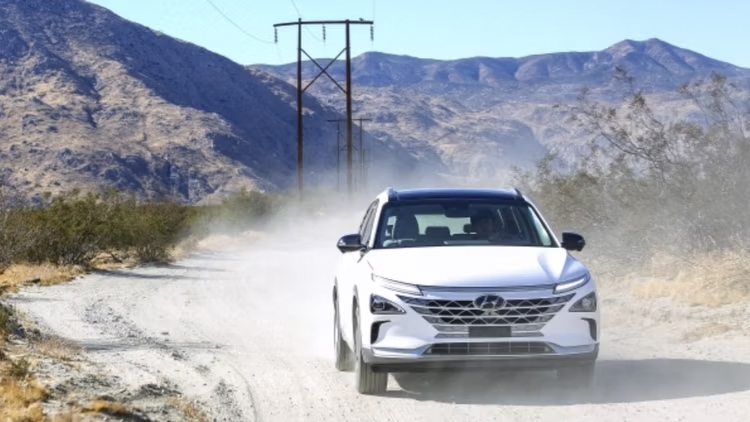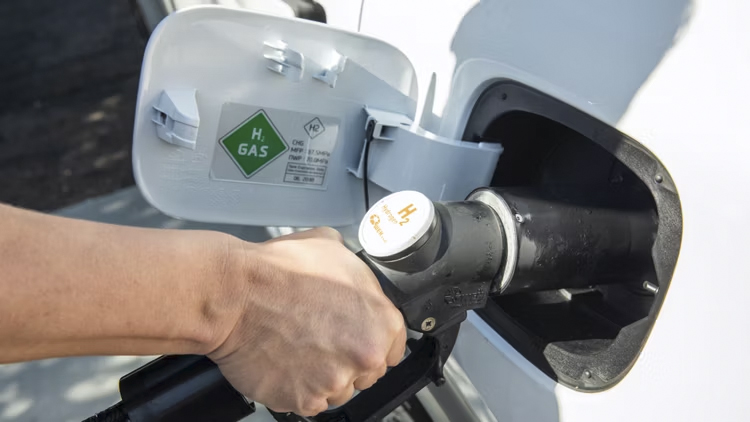|

February 22, 2024
ByNikesh Kooverjee
Here's How Much It Costs To
Refill The Hydrogen-Powered Hyundai Nexo

- Hyundai's Nexo is a costly but
eco-friendly option with limited infrastructure, costing
$226.80 to refill and covering 380 miles on a full tank.
- The Nexo doesn't emit tailpipe
emissions, qualifies for HOV lanes, and has a 0.329 drag
coefficient with 161 HP and 291 LB-FT.
- Hyundai aims to revolutionize
transportation with hydrogen fuel-cell tech, currently limited
by infrastructure growth in the U.S. and poor unit sales.
Hyundai's Nexo is a costly but eco-friendly
option with limited infrastructure, costing $226.80 to refill and
covering 380 miles on a full tank.
The Nexo doesn't emit tailpipe emissions, qualifies for HOV lanes, and
has a 0.329 drag coefficient with 161 HP and 291 LB-FT.
Hyundai aims to revolutionize transportation with hydrogen fuel-cell
tech, currently limited by infrastructure growth in the U.S. and poor
unit sales.
Hyundai is one of very few manufacturers currently heavily invested in
hydrogen fuel-cell technology. The Nexo is currently the only hydrogen
fuel-cell EV crossover sold in California. Compared to its ICE and EV
endeavors, hydrogen certainly takes a bit of a backseat, but we see
some level of interest when looking at previous concepts like the
exhilarating N Vision 74.
Naturally, there are some noteworthy drawbacks to operating a hydrogen
fuel-cell vehicle, including limited infrastructure and inflated fuel
costs. Hydrogen is a fairly costly fuel option, because it costs a lot
to generate and deliver. The fuel also requires a demanding storage
system, but you can enjoy some noteworthy savings in the early years
of ownership.
The Hyundai Nexo Starts At $60,135

The Hyundai Nexo is an incredibly costly
option, with its $60,135 starting price. However, it boasts $4,500
worth of potential rebates and comes with $15,000 worth of free
hydrogen via the H2 Fuel Card.
Unfortunately, the Nexo isn't a very popular car for Hyundai, as it
barely surpasses 420 unit sales every year. Granted, it is only
available in California, but this region consistently returns one of
the highest car sales figures every month. As of January 2024, Hyundai
has only sold 23 Nexo examples this year.
The Hyundai Nexo Costs $226.80
To Refill
According to True Zero, California's premier hydrogen supplier, one
kilogram of hydrogen will set you back by $36. The Nexo features a 6.3
kg tank, meaning you'll have to pay $226.80 to fill it up. This is
drastically more than what you'd have to spend on the average tank of
gas or to recharge a large EV battery pack.
Thankfully, Hyundai sells every Nexo with the aforementioned $15,000
hydrogen credit, but this is limited to just the first three years of
ownership. This will get you just under 66 tanks of hydrogen, which
most Californian road users are very unlikely to get through in just
36 months.
The Hyundai Nexo Covers 380 Miles On
A Full Tank

The Nexo may have one of the larger hydrogen
tanks in the very small FCEV segment, but it also struggles with the
poorest range. The EPA estimates the more efficient Blue trim will
cover 380 miles on a single tank, while the more premium Limited trim
only squeezes 354 miles on a tank.
Hyundai Nexo Energy Consumption
| |
Range |
Fuel economy rating
city/highway/combined |
Hydrogen tank capacity |
| Blue |
380 miles |
65/58/61 MPGe |
13.8 gallons |
| Limited |
354 miles |
59/54/57 MPGe |
13.8 gallons |
The Hyundai Nexo Doesn't
Produce Tailpipe Emissions
Hydrogen fuel-cell vehicles
don't produce any tailpipe emissions, making them the perfect
choice if you're an eco-conscious consumer. FCEVs also get access to
California's HOV carpool lane, so it also improves convenience in
rush hour traffic. Refueling the 13.8-gallon tank requires about
five minutes, reflecting the benefits of driving an EV mixed with
the rapid ICE refueling times.
Hyundai Nexo's Hydrogen Emissions
- Hyundai's hydrogen fuel cell vehicles only
produce water vapor as a byproduct, making it a truly zero-emission
vehicle.
- This vapor is clean and does not contribute
to air pollution.
- Hydrogen fuel cell vehicles offer a
solution to reducing greenhouse gas emissions, because they don't
emit CO2 during the chemical process.
- Hyundai's commitment to hydrogen technology
forms a part of its vision for sustainable mobility and reducing
environmental footprints.
- No traditional tailpipe emissions lead to
better air quality and public health.
- Hyundai's continued effort to invest in
hydrogen fuel cell technology expands its lineup of zero-emission
vehicles and promotes widespread adoption.
FCEVs convert hydrogen into electricity by mixing
it with air from the frontal intake system. This chemical reaction
produces electricity, of which excess energy is stored in a 1.56 kWh
battery pack. Water vapor is the only byproduct the process generates.
Hyundai has ensured the Nexo's tank is a safe and secure unit, because
of how combustible hydrogen is. The tank is surrounded by its own
crumple zone structure, which takes in kinetic energy in the event of
a crash.
The Hyundai Nexo Has A 0.329 Drag Coefficient

Like any other FCEV, the Nexo returns some
substandard performance characteristics. The single front-mounted
permanent-magnet motor only generates 161 horsepower and 291
pound-feet, resulting in a tested 8.4-second 0-60 MPH time. Hyundai
limits the top speed to 111 MPH.
| Engine |
Single-permanent-magnet motor |
| Transmission |
Single-speed automatic |
| Horsepower |
161 HP |
| Torque |
291 LB-FT |
| Driveline |
Front-wheel drive |
| 0-60 MPH |
8.4 Seconds |
| Top Speed |
111 MPH |
(Specifications sourced from Hyundai)
The Hyundai
Nexo adopts a mixture of the brand's previous and current design
languages, resulting in a rather peculiar exterior appearance. The
benefit of its odd design is a 0.329 Cd drag coefficient, while still
maintaining conventional crossover proportions.

Californians currently have access to 59
different hydrogen stations. The most popular areas like San Francisco
and Los Angeles benefit from the most locations. There are two
stations in Sacramento and one just outside Truckee.
- Electrolysis is the most expensive process
when forming hydrogen.
- Solar and wind are key renewable sources
when lowering hydrogen production's carbon footprint.
- Hydrogen refueling stations are still
expensive to construct, but new developments have lowered costs.
- Incentives and subsidies play a significant
role in offsetting hydrogen production and infrastructure costs.
- The best way to reduce hydrogen costs is by
scaling up production and improving distribution systems.
- Research and development efforts aim to
innovate technologies and processes to further decrease the cost of
hydrogen in the USA.
Shell's decision to close seven hydrogen stations
came as a noteworthy blow to FCEV owners, because it negatively
affected the already limited infrastructure. This also impacts how
successful automakers can make these products. The Nexo's poor unit
sales reflect this.
Hydrogen
Stations In The U.S.
According to
the Department of Energy, key suppliers are planning to add 50 new
hydrogen stations for FCEV owners. They will break ground on five new
stations in northeastern states, further improving the
viability of hydrogen cars for American road users.
- The hydrogen refueling station network in
the U.S. is steadily growing in California and other states.
- California has the best hydrogen station
deployment, and plans to build a comprehensive network to improve
fuel cell vehicle support.
- Public and private partnerships are vital
for funding and developing hydrogen refueling infrastructure across
the U.S.
- Hydrogen station locations are
strategically chosen to support key transportation corridors and
urban centers.
- Hydrogen availability influences consumer
confidence and adoption of fuel-cell vehicles.
- Continued hydrogen infrastructure
investment is essential to support the growth of the hydrogen
economy and decarbonize transportation in the U.S.
The DoE is also heading up an H2USA campaign.
This recruits federal agencies, automakers, hydrogen providers, fuel
cell developers, national laboratories, and additional stakeholders to
further improve hydrogen supply across the country. It's evident that
the uptake is not as urgent as electric car charging stations, of
which there are already well over 160,000 nation-wide, but it's still
a valiant and admirable
endeavor to diversify green fuels and lower the national carbon
footprint.
Green Play Ammonia™, Yielder® NFuel Energy.
Spokane, Washington. 99212
509 995 1879
Cell, Pacific Time Zone.
General office:
509-254
6854
4501 East Trent
Ave.
Spokane, WA 99212
|